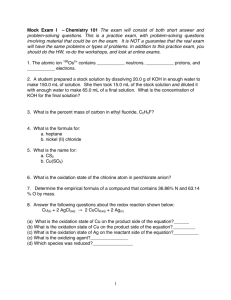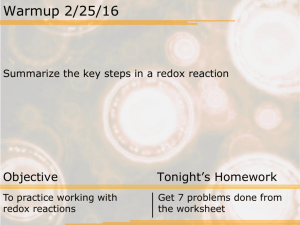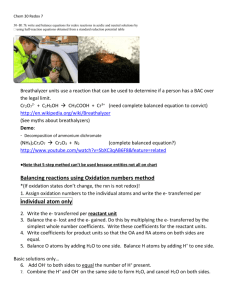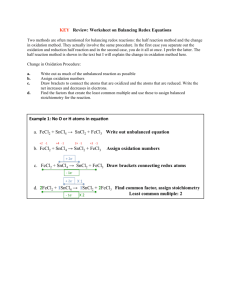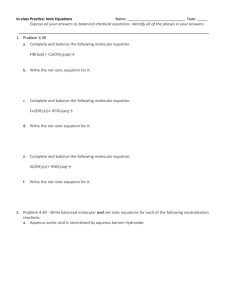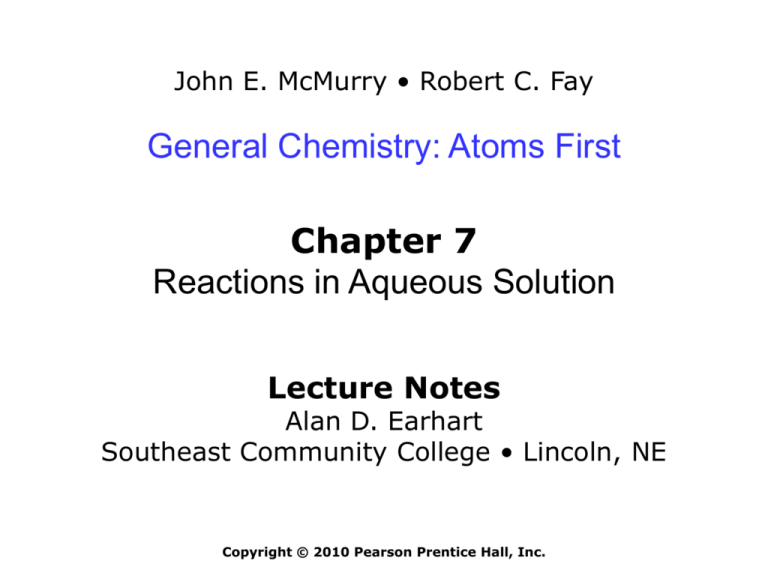
John E. McMurry • Robert C. Fay
General Chemistry: Atoms First
Chapter 7
Reactions in Aqueous Solution
Lecture Notes
Alan D. Earhart
Southeast Community College • Lincoln, NE
Copyright © 2010 Pearson Prentice Hall, Inc.
Reactions in Solution
1. Precipitation Reactions
2. Neutralization Reactions
3. Redox Reactions
Copyright © 2010 Pearson Prentice Hall, Inc.
Chapter 7/2
Some Ways That Chemical
Reactions Occur
Precipitation Reaction: A process in which soluble
ionic reactants yield an insoluble solid product that
falls out of solution.
Pb(NO3)2(aq) + 2KI(aq)
2KNO3(aq) + PbI2(s)
Chapter 7/3
Some Ways That Chemical
Reactions Occur
Acid-Base Neutralization Reactions: Processes in
which an acid reacts with a base to yield water plus an
ionic compound called a salt.
HCl(aq) + NaOH(aq)
H2O(l) + NaCl(aq)
Chapter 7/4
Some Ways That Chemical
Reactions Occur
Oxidation-Reduction (Redox) Reactions: Processes
in which one or more electrons are transferred
between reaction partners (atoms, molecules, or ions).
Mg(s) + 2HCl(aq)
MgCl2(aq) + H2(g)
Chapter 7/5
Electrolytes in Aqueous
Solution
Electrolytes: Substances which dissolve in water to
produce conducting solutions of ions.
H 2O
Na1+(aq) + Cl1-(aq)
NaCl(s)
Nonelectrolytes: Substances which do not produce
ions in aqueous solutions.
H 2O
C12H22O11(s)
C12H22O11(aq)
Chapter 7/6
Electrolytes in Aqueous
Solution
Strong Electrolytes: Compounds that dissociate to a
large extent into ions when dissolved in water.
H 2O
HCl(g)
H1+(aq) + Cl1-(aq)
Weak Electrolytes: Compounds that dissociate to a
small extent into ions when dissolved in water.
CH3CO2H(aq)
H1+(aq) + CH3CO21-(aq)
Chapter 7/8
Electrolytes in Aqueous
Solution
Strong Acids: hydrochloric acid, hydrobromic acid,
hydroiodic acid, perchloric acid, nitric acid, sulfuric acid.
Electrolytes in Aqueous
Solution
Ionic compounds
Chapter 7/10
Electrolytes in Aqueous
Solution
Weak acids
Chapter 7/11
Electrolytes in Aqueous
Solution
Molecular compounds (other than any strong or weak
Chapter 7/12
electrolytes)
Electrolytes in Aqueous
Solution
Dissociation Equations
H 2O
2Na1+(aq) + SO42-(aq)
Na2SO4(s)
H 2O
FeBr3(s)
Fe3+(aq) + 3Br1-(aq)
Chapter 7/13
Aqueous Reactions and Net
Ionic Equations
Molecular Equation: All substances in the chemical
equation are written using their complete formulas as
if they were molecules.
Pb(NO3)2(aq) + 2KI(aq)
strong electrolytes
2KNO3(aq) + PbI2(s)
precipitate
Chapter 7/14
Aqueous Reactions and Net
Ionic Equations
Ionic Equation: All of the strong electrolytes are
written as ions.
Pb(NO3)2(aq)
2KI(aq)
Pb2+(aq) + 2NO31- (aq) + 2K1+(aq) + 2I1-(aq)
2K1+(aq) + 2NO31- (aq) + PbI2(s)
2KNO3(aq)
Chapter 7/15
Aqueous Reactions and Net
Ionic Equations
Spectator Ions: Ions that undergo no change during
the reaction and appear on both sides of the reaction
arrow.
Pb2+(aq) + 2NO31- (aq) + 2K1+(aq) + 2I1-(aq)
2K1+(aq) + 2NO31- (aq) + PbI2(s)
Chapter 7/16
Aqueous Reactions and Net
Ionic Equations
Net Ionic Equation: Only the ions undergoing change
are shown.
Pb2+(aq) + 2I1-(aq)
PbI2(s)
Chapter 7/17
Precipitation Reactions and
Solubility Guidelines
Solubility: States how much of a compound will
dissolve in a given amount of solvent at a given
temperature.
Chapter 7/18
Precipitation Reactions and
Solubility Guidelines
1. A compound is probably soluble if it contains one of
the following cations:
• Group 1A cation: Li1+, Na1+, K1+, Cs1+
• Ammonium ion: NH41+
2. A compound is probably soluble if it contains one of
the following anions:
• Halide: Cl1-, Br1-, I1• except Ag1+, Hg22+, and Pb2+ compounds
• Nitrate (NO31-), perchlorate (ClO41-), acetate (CH3CO21-),
sulfate (SO42-)
• except Ba2+, Hg22+, and Pb2+ sulfates
Chapter 7/19
Precipitation Reactions and
Solubility Guidelines
Write the molecular, ionic, and net ionic equations for
the reaction that occurs when aqueous solutions of
AgNO3 and Na2CO3 are mixed.
Chapter 7/20
Precipitation Reactions and
Solubility Guidelines
Write the molecular, ionic, and net ionic equations for
the reaction that occurs when aqueous solutions of
AgNO3 and Na2CO3 are mixed.
1. Write the unbalanced chemical formulas of the
products (use proper ionic rules).
AgNO3(aq) + Na2CO3(aq)
AB + CD
Ag2CO3
+ NaNO3
CB + AD
double replacement reaction
Chapter 7/21
Precipitation Reactions and
Solubility Guidelines
Write the molecular, ionic, and net ionic equations for
the reaction that occurs when aqueous solutions of
AgNO3 and Na2CO3 are mixed.
2. Molecular Equation: Balance the equation and
predict the solubility of each possible product.
2AgNO3(aq) + Na2CO3(aq)
Ag2CO3(s) + 2NaNO3(aq)
Neither the cation nor the
anion is in the solubility list.
Contains a group 1A cation.
Chapter 7/22
Precipitation Reactions and
Solubility Guidelines
Write the molecular, ionic, and net ionic equations for
the reaction that occurs when aqueous solutions of
AgNO3 and Na2CO3 are mixed.
3. Ionic Equation: Dissociate the soluble ionic
compounds.
2AgNO3(aq)
Na2CO3(aq)
2Ag1+(aq) + 2NO31- (aq) + 2Na1+(aq) + CO32-(aq)
Ag2CO3(s) + 2Na1+(aq) + 2NO31-(aq)
2NaNO3(aq)
Chapter 7/23
Precipitation Reactions and
Solubility Guidelines
Write the molecular, ionic, and net ionic equations for
the reaction that occurs when aqueous solutions of
AgNO3 and Na2CO3 are mixed.
4. Net Ionic Equation: Eliminate the spectator ions from
the ionic equation.
2Ag1+(aq) + 2NO31- (aq) + 2Na1+(aq) + CO32-(aq)
Ag2CO3(s) + 2Na1+(aq) + 2NO31-(aq)
2Ag1+(aq) + CO32-(aq)
Ag2CO3(s)
Chapter 7/24
Acids, Bases, and
Neutralization Reactions
Arrhenius Acid: A substance that dissociates in water
to produce hydrogen ions, H1+:
HA(aq)
H1+(aq) + A1-(aq)
HCl(aq)
H1+(aq) + Cl1-(aq)
In water, acids produce hydronium ions, H3O1+:
HCl(aq) + H2O(aq)
H3O1+(aq) + Cl1-(aq)
Chapter 7/25
Acids, Bases, and
Neutralization Reactions
Arrhenius Base: A substance that dissociates in
water to produce hydroxide ions, OH1-:
MOH(aq)
M1+(aq) + OH1-(aq)
NaOH(aq)
Na1+(aq) + OH1-(aq)
Ammonia in water, commonly called “ammonium
hydroxide”, is a base:
NH3(aq) + H2O(aq)
NH41+(aq) + OH1-(aq)
Chapter 7/26
Acids, Bases, and
Neutralization Reactions
Strong acids and strong bases are strong electrolytes.
Weak acids and weak bases are weak electrolytes.
Chapter 7/27
“ous”
“ic”
“ite”
“ate”
Chapter 7/28
Acids, Bases, and
Neutralization Reactions
Binary Acids
HCl
hydrochloric acid
HBr
hydrobromic acid
HF
hydrofluoric acid
Chapter 7/29
Acids, Bases, and
Neutralization Reactions
These acid-base neutralization reactions are doublereplacement reactions just like the precipitation
reactions:
HA + MOH
MA + HOH
or
HA + MOH
Acid
Base
MA + H2O
Salt
Water
Chapter 7/30
Acids, Bases, and
Neutralization Reactions
Write the molecular, ionic, and net ionic equations for
the reaction of aqueous HBr and aqueous Ba(OH)2.
1. Write the chemical formulas of the products (use
proper ionic rules for the salt).
HBr(aq) + Ba(OH)2(aq)
Acid
Base
H2O
+ BaBr2
Water
Salt
Chapter 7/31
Acids, Bases, and
Neutralization Reactions
Write the molecular, ionic, and net ionic equations for
the reaction of aqueous HBr and aqueous Ba(OH)2.
2. Molecular Equation: Balance the equation and
predict the solubility of the salt in the products.
2HBr(aq) + Ba(OH)2(aq)
2H2O(l) + BaBr2(aq)
Use the solubility rules.
Halides are soluble: Cl1-, Br1-, I1 except compounds of Ag1+, Hg22+, and Pb2+
Chapter 7/32
Acids, Bases, and
Neutralization Reactions
Write the molecular, ionic, and net ionic equations for
the reaction of aqueous HBr and aqueous Ba(OH)2.
3. Ionic Equation: Dissociate a strong acid and the
soluble ionic compounds.
2HBr(aq)
Ba(OH)2(aq)
2H1+(aq) + 2Br1-(aq) + Ba2+(aq) + 2OH1-(aq)
2H2O(l) + Ba2+(aq) + 2Br1-(aq)
BaBr2(aq)
Chapter 7/33
Acids, Bases, and
Neutralization Reactions
Write the molecular, ionic, and net ionic equations for
the reaction of aqueous HBr and aqueous Ba(OH)2.
4. Net Ionic Equation: Eliminate the spectator ions from
the ionic equation.
2H1+(aq) + 2Br1-(aq) + Ba2+(aq) + 2OH1-(aq)
2H2O(l) + Ba2+(aq) + 2Br1-(aq)
2H1+(aq) + 2OH1-(aq)
or
H1+(aq) + OH1-(aq)
2H2O(l)
H2O(l)
Chapter 7/34
Acids, Bases, and
Neutralization Reactions
Write the molecular, ionic, and net ionic equations for
the reaction of aqueous NaOH and aqueous HF.
1. Write the chemical formulas of the products (use
proper ionic rules for the salt).
HF(aq) + NaOH(aq)
Acid
Base
H2O
Water
+ NaF
Salt
Chapter 7/35
Acids, Bases, and
Neutralization Reactions
Write the molecular, ionic, and net ionic equations for
the reaction of aqueous NaOH and aqueous HF.
2. Molecular Equation: Balance the equation and
predict the solubility of the salt in the products.
HF(aq) + NaOH(aq)
H2O(l) + NaF(aq)
Use the solubility rules.
• Compounds based on Group 1A cations: Li1+,
Na1+, K1+, Cs1+ are soluble.
Chapter 7/36
Acids, Bases, and
Neutralization Reactions
Write the molecular, ionic, and net ionic equations for
the reaction of aqueous NaOH and aqueous HF.
3. Ionic Equation: Dissociate a strong acid and the
soluble ionic compounds.
NaOH(aq)
HF(aq) + Na1+(aq) + OH1-(aq)
H2O(l) + Na1+(aq) + F1-(aq)
NaF(aq)
Chapter 7/37
Acids, Bases, and
Neutralization Reactions
Write the molecular, ionic, and net ionic equations for
the reaction of aqueous NaOH and aqueous HF.
4. Net Ionic Equation: Eliminate the spectator ions from
the ionic equation.
HF(aq) + Na1+(aq) + OH1-(aq)
HF(aq) + OH1-(aq)
H2O(l) + Na1+(aq) + F1-(aq)
H2O(l) + F1-(aq)
Chapter 7/38
Oxidation-Reduction Reactions
(Redox)
Chapter 7/39
Redox Reactions - OIL RIG
(oxidation is loss / reduction is gain)
4Fe(s) + 3O2(g)
2Fe2O3(s) + 3C(s)
2Fe2O3(s)
4Fe(s) + 3CO2(g)
Rusting of iron:
an oxidation rxn
of Fe (Fe loses e-)
Manufacture of iron:
a reduction rxn of
Fe (Fe gains e-)
Chapter 7/40
Oxidation-Reduction (Redox)
Reactions
OIL RIG
Oxidation: The loss of one or more electrons by a
substance, whether element, compound, or ion.
Reduction: The gain of one or more electrons by a
substance, whether element, compound, or ion.
Chapter 7/41
Oxidation-Reduction (Redox)
Reactions
Oxidation Number (State): A value which indicates
whether an atom is neutral, electron-rich, or electronpoor.
Rules for Assigning Oxidation Numbers
1. An atom in its elemental state has an oxidation
number of 0.
Na
H2
Br2
S
Ne
Oxidation number 0
Chapter 7/42
Oxidation-Reduction (Redox)
Reactions
2. An atom in a monatomic ion has an oxidation
number identical to its charge.
Na1+
Ca2+
Al3+
Cl1-
O2-
+1
+2
+3
-1
-2
Chapter 7/43
Oxidation-Reduction (Redox)
Reactions
3. An atom in a polyatomic ion or in a molecular
compound usually has the same oxidation number
it would have if it were a monatomic ion.
a) Hydrogen can be either +1 or -1.
1-
H
O
+1
-2
H
Ca H
-1
+2
-1
b) Oxygen usually has an oxidation number of -2.
H
+1
O
-2
H
+1
H
+1
O
-1
O
-1
H
+1
Chapter 7/44
Oxidation-Reduction (Redox)
Reactions
3.
c) Halogens usually have an oxidation number of -1.
H
Cl
+1
-1
Cl
+1
O
-2
Cl
+1
Chapter 7/45
Oxidation-Reduction (Redox)
Reactions
4. The sum of the oxidation numbers is 0 for a neutral
compound and is equal to the net charge for a
polyatomic ion.
H2SO3
+1
x
-2
Cr2O72x
-2
2(+1) + x + 3(-2) = 0 (net charge)
x = +4
2(x) + 7(-2) = -2 (net charge)
x = +6
Chapter 7/46
START
Identifying Redox Reactions
Reducing Agent (Fe)
• Causes reduction
• Loses one or more e• Undergoes oxidation
• Atom’s oxidation # increases
0
oxidation
4Fe(s) + 3O2(g)
0
Oxidizing Agent (O2)
• Causes oxidation
• Gains one or more e• Undergoes reduction
• Atom’s oxidation # decreases
+3
2Fe2O3(s)
reduction
-2
Chapter 7/47
Identifying Redox Reactions
Reducing Agent (C)
oxidation
0
2Fe2O3(s) + 3C(s)
+3
+4
4Fe(s) + 3CO2(g)
0
reduction
Oxidizing Agent (Fe)
Chapter 7/48
Identify the Oxidizing and Reducing
Agents in Each of the Following
3 H2S + 2 NO3– + 2 H+ 3 S + 2 NO + 4 H2O
MnO2 + 4 HBr MnBr2 + Br2 + 2 H2O
49
Identify the Oxidizing and Reducing
Agents in Each of the Following
red agent ox agent
3 H2S + 2 NO3– + 2 H+ 3 S + 2 NO + 4 H2O
+1 -2
+5 -2
+1
0
+2 -2
+1 -2
oxidation
reduction
ox ag
red ag
+4 -2
+1 -1
MnO2 + 4 HBr MnBr2 + Br2 + 2 H2O
+2 -1
0
+1 -2
oxidation
reduction
50
The redox Activity Series of
the Elements
Which one of these reactions will occur?
The forward rxn or the reverse rxn?
Cu(s) + 2Ag1+(aq)
Cu2+(aq) + 2Ag(s)
2Ag(s) + Cu2+(aq)
2Ag1+(aq) + Cu(s)
Chapter 7/51
The Activity Series of the
Elements
The elements that
are higher up in the
table are more likely
to be oxidized.
Thus, any element
higher in the activity
series will reduce
the ion of any
element lower in the
activity series.
Chapter 7/53
54
55
Half Reactions
Given a total reaction
Cu(s) + Ag1+(aq)
Cu2+(aq) + Ag(s)
Isolate the reaction of Cu in one equation
Cu(s)
Cu2+(aq)
Isolate the reaction of Ag in one equation
Ag1+(g)
Ag(s)
Find the correct half reaction on the following lists
Chapter 7/56
stop
Balancing Redox Reactions:
Basic Solution
Acidic Solution
The Half-Reaction Method
Balancing Redox Rxns (Basic Solution)
1) Write the unbalanced equation
2) Assign oxidation numbers to the atoms
a) determine which element is oxidized and which is reduced
3) Write redox half-reactions, including electrons
a) oxidation :electrons on the right of arrow
b) reduction: electrons on left of arrow
4) Balance the half-reactions by mass
a) first balance elements other than H and O
b) next, balance O by adding H2O wherever an O is needed
c) then add H+1 where a H is needed
d) neutralize all H+ (acid) with OH- (base)
5) Balance half-reactions by charge
a) balance charge by adjusting electrons
6) Balance electrons between half-reactions
7) Add half-reactions together
8) Check the answer
58
Balancing Redox Rxns (Acid Solution)
1) Write the unbalanced equation
2) Assign oxidation numbers to the atoms
a) determine which element is oxidized and which is reduced
3) Write redox half-reactions, including electrons
a) oxidation :electrons on the right of arrow
b) reduction: electrons on left of arrow
4) Balance the half-reactions by mass
a) first balance elements other than H and O
b) next, balance O by adding H2O wherever an O is needed
c) then add H+1 where a H is needed
5) Balance half-reactions by charge
a) balance charge by adjusting electrons
6) Balance electrons between half-reactions
7) Add half-reactions together
8) Check the answer
59
Balancing Redox Reactions:
The Half-Reaction Method
Balance the following net ionic equation in acidic solution:
STEP 1: WRITE THE UNBALANCED EQUATION
I1-(aq) + Cr2O72-(aq)
Cr3+(aq) + IO31-(aq)
STEP 2: ASSIGN OXIDATION STATES
I1-(aq) + Cr2O72-(aq)
Cr3+(aq) + IO31-(aq)
1-
3+
(6+)(2-)
(5+)(2-)
I goes from 1- to 5+ (LOSES e-) = OXIDIZED
Cr goes from 6+ to 3+ (GAINS e-) = REDUCED
Chapter 7/60
Balancing Redox Reactions:
The Half-Reaction Method
STEP 3: Write the two unbalanced half-reactions
I1-(aq)
OX:
RED: Cr2O72-(aq) + e-
IO31-(aq) + e-
Cr3+(aq)
STEP 4: Balance the half-reactions by mass (excluding O & H)
I1-(aq)
IO31-(aq)
OX:
one Iodine
RED:
Cr2O72-(aq)
two Chromium
one Iodine
2Cr3+(aq)
two Chromium
Chapter 7/61
Balancing Redox Reactions:
The Half-Reaction Method
STEP 4: Balance the half-reactions by mass –
add water wherever O is needed.
OX:
I1-(aq) + 3H2O
RED: Cr2O72-(aq)
IO31-(aq)
2Cr3+(aq) + 7H2O
STEP 4: Balance the half-reactions by mass –
add H+ wherever H is needed.
OX:
I1-(aq) + 3H2O
RED: Cr2O72-(aq) + 14H+
IO31-(aq) + 6H+
2Cr3+(aq) + 7H2O
Chapter 7/62
Balancing Redox Reactions:
The Half-Reaction Method
STEP 5: Balance the half-reactions by charge
I1-(aq) + 3H2O
(1-)=1-
IO31-(aq) + 6H+ + 6x e-
(1-)+(6+)+(x)=1-
Cr2O72-(aq) + 14H+ + 6x e-
(2-)+(14+)+(x)=6+ X=6-
X=6-
2Cr3+(aq)+ 7H2O
(6+)=6+
Chapter 7/63
Balancing Redox Reactions:
The Half-Reaction Method
STEP 6 : Balance electrons between half-reactions
-
I1-(aq) + 3H2O
IO31-(aq) + 6H+ + 6e
Cr2O72-(aq) + 14H+ + 6e-
2Cr3+(aq) + 7H2O
Electrons are balanced as is
STEP 7 : Add the half-reactions
I1-(aq) + 3H2O
IO31-(aq) + 6H+ + 6e-
Cr2O72-(aq) + 14H+ + 6e8
I1-(aq) + Cr2O72-(aq) + 8H+
2Cr3+(aq) + 7H2O 4
IO31-(aq) +2Cr3+(aq) +4H2O
Chapter 7/64
Balancing Redox Reactions:
The Half-Reaction Method
Balance the following net ionic equation in basic
solution:
MnO41-(aq) + Br1-(aq)
MnO2(s) + BrO31-(aq)
Chapter 7/65
Balancing Redox Reactions:
The Half-Reaction Method
•
Write the two unbalanced half-reactions.
Ox:
Red:
Br1-(aq)
MnO41-(aq)
BrO31-(aq)
MnO2(s)
• Write oxidation states
Br- = -1
-6 eMnO41-
X+ 4(-2)=1X=+7
BrO3-
MnO2
+3 e-
X+ 3(-2)=1X=+5
X+ 2(-2)=0
X=+4
Chapter 7/66
Balancing Redox Reactions:
The Half-Reaction Method
•
Balance both half-reactions for all atoms except O and H.
Br1-(aq)
BrO31-(aq) + e-
e- + MnO41-(aq)
MnO2(s)
Both Br and Mn are balanced
• Balance O by adding H2O
3H2O + Br1-(aq)
MnO41-(aq)
BrO31-(aq)
MnO2(s) + 2H2O
Chapter 7/67
Balancing Redox Reactions:
The Half-Reaction Method
•
Balance each half-reaction for H by adding H1+.
3H2O(l) + Br1-(aq)
+4H1+(aq) + MnO41-(aq)
BrO31-(aq) + 6H1+(aq)
MnO2(s) + 2H2O(l)
• Since in basic solution, add OH- for each H1+.
3H2O(l) + Br1-(aq) + 6OHBrO31-(aq) + 6H1+ + 6OH3H2O(l) + Br1-(aq) + 6OH-
-
4OH + 4H1+ + MnO41-(aq)
4H2O(l) + MnO4
2
1-(aq)
BrO31-(aq) + 6H2O
3
MnO2(s) + 2H2O(l) + 4OHMnO2(s) + 2H2O(l) + 4OHChapter 7/68
Balancing Redox Reactions:
The Half-Reaction Method
•
Balance each half-reaction for charge by adding
electrons to the side with greater positive charge.
Br1-(aq) + 6OH(1-)+(6-)=7-
3xe-
+ 2H2O(l) + MnO4
x+(1-)=4-
1-(aq)
X=3-
BrO31-(aq) + 3H2O(l) + x6 e(1-)+(x)=7x=6MnO2(s) + 4OH-
4-
Chapter 7/69
Balancing Redox Reactions:
The Half-Reaction Method
•
Multiply each half-reaction by a factor to make the
electron count the same in both half-reactions.
Br1-(aq) + 6OH-
2
3e-
+ 2H2O(l) + MnO4
BrO31-(aq) + 3H2O(l) + 6e1-(aq)
MnO2(s) + 4OH-
Chapter 7/70
Balancing Redox Reactions:
The Half-Reaction Method
•
Add the two balanced half-reactions together and
cancel species that appear on both sides of the
equation.
6OH-(aq) + Br1-(aq)
6e-
BrO31-(aq) + 3H2O(l) + 6e-
+ 4H2O(l) + 2MnO4
1-(aq)
2
2MnO2(s) + 8OH-(aq)
H2O(l) + 2MnO41-(aq) + Br1-(aq)
2MnO2(s) + 2OH-(aq) + BrO31-(aq)
Chapter 7/71
stop
Balance the equation:
I(aq) + MnO4(aq) I2(aq) + MnO2(s) in basic solution
Assign
Oxidation
States
Separate
into halfreactions
I(aq) + MnO4(aq) I2(aq) + MnO2(s)
ox: I(aq) I2(aq)
red: MnO4(aq) MnO2(s)
72
Balance the equation:
I(aq) + MnO4(aq) I2(aq) + MnO2(s) in basic solution
Balance halfreactions by
mass
ox: I(aq) I2(aq)
red: MnO4(aq) MnO2(s)
Balance halfreactions by
mass
ox: 2 I(aq) I2(aq)
red: MnO4(aq) MnO2(s)
Balance halfox: 2 I(aq) I2(aq)
reactions by
red: MnO4(aq) MnO2(s) + 2 H2O(l)
mass, then O by
adding H2O
73
Balance the equation:
I(aq) + MnO4(aq) I2(aq) + MnO2(s) in basic solution
Balance
ox: 2 I(aq) I2(aq)
half-rxns red: 4 H+(aq) + MnO4(aq) MnO2(s) + 2 H2O(l)
by mass
then H by
adding H+
Balance
ox: 2 I(aq) I2(aq)
half-rxns red: 4 H+(aq) + MnO4(aq) MnO2(s) + 2 H2O(l)
by mass
+
4
H
+
4
OH
+
MnO
MnO
+
2
H
O
+
4
OH
(aq)
(aq)
4
(aq)
2(s)
2
(l)
(aq)
in base,
2 H2O
neutralize 4 H2O(aq) + MnO4(aq) MnO2(s) + 2 H2O(l) + 4 OH(aq)
the H+
MnO4(aq) + 2 H2O(l) MnO2(s) + 4 OH(aq)
with OH
74
Balance the equation:
I(aq) + MnO4(aq) I2(aq) + MnO2(s) in basic solution
Balance
Halfrxns by
charge
Balance
electrons
between
half-rxns
ox: 2 I(aq) I2(aq) + 2 e
red: MnO4(aq) + 2 H2O(l) + 3 e MnO2(s) + 4 OH(aq)
ox: 2 I(aq) I2(aq) + 2 e } x3
red: MnO4(aq) + 2 H2O(l) + 3 e MnO2(s) + 4 OH(aq) }x2
ox: 6 I(aq) 3 I2(aq) + 6 e
red: 2 MnO4(aq) + 4 H2O(l) + 6 e 2 MnO2(s) + 8 OH(aq)
75
Balance the equation:
I(aq) + MnO4(aq) I2(aq) + MnO2(s) in basic solution
Add the ox: 6 I(aq) 3 I2(aq) + 6 e
Halfred: 2 MnO4(aq) + 4 H2O(l) + 6 e 2 MnO2(s) + 8 OH(aq)
reactions 6 I(aq)+ 2 MnO4(aq) + 4 H2O(l) 3 I2(aq)+ 2 MnO2(s) + 8 OH(aq)
Check
Reactant
Count
Element
Product
Count
6
I
6
2
Mn
2
12
O
12
8
H
8
8
charge
8
76
Practice Balancing Equations
H2O2 + KI + H2SO4 K2SO4 + I2 + H2O
+1 -1
+1 -1
+1 +6 -2
+1 +6 -2
oxidation
reduction
0
+1 -2
ox: 2 I-1 I2 + 2e-1
red: H2O2 + 2e-1 + 2 H+ 2 H2O
tot 2 I-1 + H2O2 + 2 H+ I2 + 2 H2O
1 H2O2 + 2 KI + H2SO4 K2SO4 + 1 I2 + 2 H2O
77
Practice - Balance the Equation
ClO3-1 + Cl-1 Cl2 (in acid)
+5 -2
-1
0
oxidation
reduction
ox: 2 Cl-1 Cl2 + 2 e-1 } x5
red: 2 ClO3-1 + 10 e-1 + 12 H+ Cl2 + 6 H2O} x1
tot 10 Cl-1 + 2 ClO3-1 + 12 H+ 6 Cl2 + 6 H2O
1 ClO3-1 + 5 Cl-1 + 6 H+1 3 Cl2 + 3 H2O
78
Redox Stoichiometry
Titration: A procedure for determining the concentration
of a solution by allowing a carefully measured volume to
react with a solution of another substance (the standard
solution) whose concentration is known.
(Oxalic acid) + Potassium permanganate
5H2C2O4(aq) + 2MnO41-(aq) + 6H1+(aq)
10CO2(g) + 2Mn2+(aq) + 8H2O(l)
K+ is a spectator ion and it
is not shown in the net ionic equation
Chapter 7/79
Chapter 7/80
Redox Stoichiometry
A solution is prepared with 0.2585 g of oxalic acid (H2C2O4).
22.35 mL of an unknown potassium permanganate solution
are needed to titrate the oxalic acid solution. What is the
concentration of the potassium permanganate solution?
5H2C2O4(aq) + 2MnO41-(aq) + 6H1+(aq)
10CO2(g) + 2Mn2+(aq) + 8H2O(l)
Mass of
H 2 C 2 O4
Moles of
H 2 C 2 O4
Molar Mass of
H2C2O4
1 mol
90.04 g
oxalic acid
Moles of
KMnO4
Mole Ratio
2 mol KMnO4
5 mol H2C2O4
Molarity of
KMnO4
Molarity of
KMnO4
158 g KMnO4
1 mole KMnO4
Chapter 7/81
Redox Stoichiometry
5H2C2O4(aq) + 2MnO41-(aq) + 6H1+(aq)
10CO2(g) + 2Mn2+(aq) + 8H2O(l)
Moles of H2C2O4 available:
0.2585 g H2C2O4
x
1 mol
90.04 g
= 0.002871 mol H2C2O4
Moles of KMnO4 reacted:
0.002871 mol H2C2O4 2 mol KMnO4
x
= 0.001148 mol KMnO4
5 mol H2C2O4
Chapter 7/82
Redox Stoichiometry
5H2C2O4(aq) + 2MnO41-(aq) + 6H1+(aq)
10CO2(g) + 2Mn2+(aq) + 8H2O(l)
Concentration of KMnO4 solution:
0.001148 mol KMnO4
22.35 mL
1000 mL
x
1L
= 0.05136 M KMnO4
Chapter 7/83


